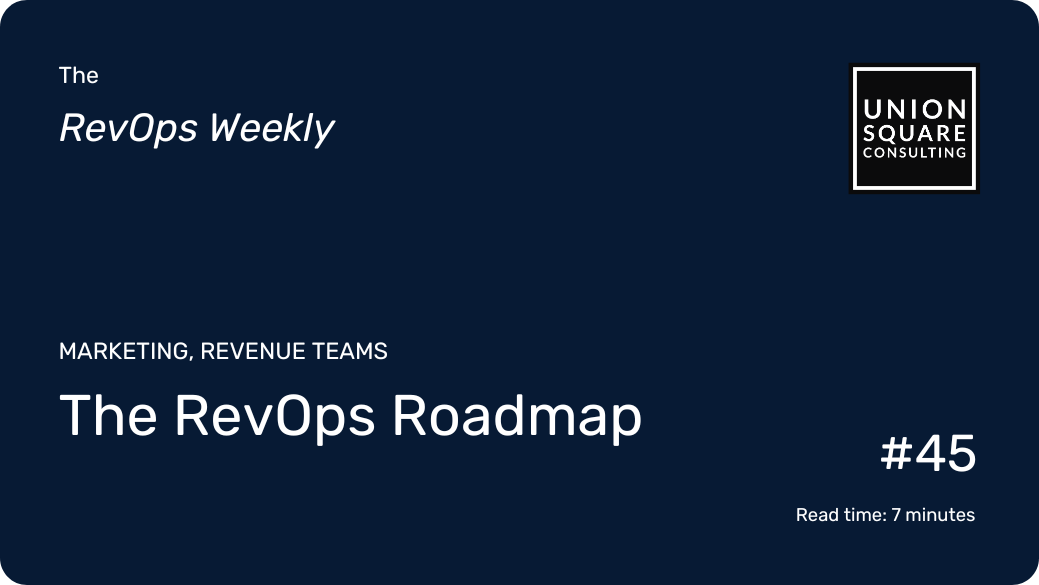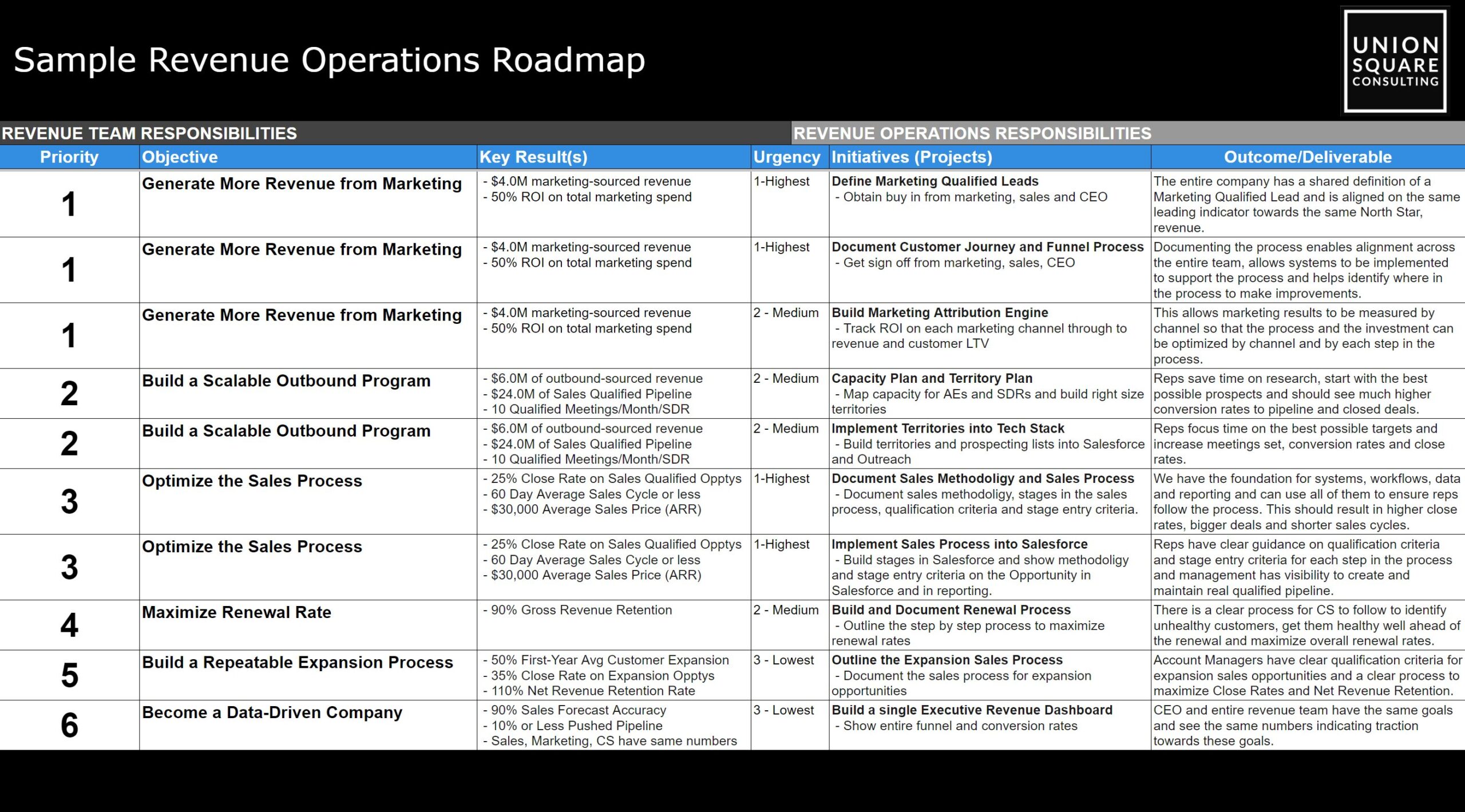
The RevOps Roadmap
Read time: 7 minutesLast week, we launched the new version of our Revenue Efficiency Pyramid, a tool used to help you assess your company’s operational maturity. But once you’re aware of the gaps in your processes and systems, how do you plan and prioritize the projects needed to fix them?
This is where the RevOps Roadmap comes into play.
- Align your teams around high-impact operational goals
- Break those goals into manageable sprints
- And plan those sprints in the correct order
Most importantly, your Roadmap will help you proactively prioritize strategic RevOps projects in between the daily flurry of ad hoc requests and fire drills – giving you more power to say “no” when you need to.
We’ve discussed the RevOps Roadmap before, so what makes this newsletter different?
We’ve been taking a good hard look at our proprietary models and how we can make them more actionable, understandable, and effective for our audience to learn and use.
Today, we’ll show you the new and improved step-by-step process for creating your own RevOps Roadmap.
Step 1: Outline Your Grand Plans
First, you need to identify the goals, or Grand Plans, of the Revenue Team. These could be OKRs (Objectives and Key Results) or any other framework your company uses to set specific and measurable goals.
Remember that this Roadmap is not used for:
- Ad hoc requests
- Non-strategic initiatives
- Or regular business practices
It is used for:
- Strategic Planning
- Alignment with Leadership
- Optimizing the Revenue Engine
Keep this in mind as you think about your goals. When we work with our clients, we use the Revenue Efficiency Pyramid to quickly identify the highest-impact starting point, making that our first priority Grand Plan.
Good examples of Grand Plans:
“We want to improve the Sales Process”
“We want to maximize our Renewal Rate”
“We want to build a scalable Outbound Program.”
If you use the OKRs framework, these would be objectives, and we can tie one or more measurable Key Result to each of them. For example, we may want to achieve a 35% close rate and a 60 day sales cycle by improving the sales process.
Bad examples of Grand Plans:
“We need to automate XYZ”
“We need to build a dashboard.”
“We want to knock out all of our daily tasks”
The first two bad examples here are more like initiatives, which we’ll cover next, and the last one is a daily task that is outside the scope of a RevOps Roadmap.
Step 2: Prioritize Initiatives or Projects
Next, we need to identify the RevOps initiatives or projects we need to tackle to achieve our goals, or Grand Plans. To do this, we break the goal up into the three fundamental pieces of every complex business system:
- The process used to define and deploy your strategy
- The technology that supports your strategy
- The people executing your strategy
Process:
- Is the process as simple as possible?
- Is it clearly defined and documented?
- Have we trained the team on the process?
- Does everyone on our team understand it?
- Can we report on whether it’s being executed?
Technology:
- How many tools are involved in this process?
- How is the process executed in our tech stack?
- Are there more effective ways to do it with tech?
- Are there more efficient workflows we can implement?
- Is the tech tracking the data to understand performance?
People:
- Have we deployed the right team against the goal?
- Are they incentivized correctly to execute the process
- Are they executing the process and achieving desired results??
- Do they have the resources they need to do their job effectively?
Once you’ve put your Grand Plan under the microscope at each of these angles, identify the gap or issue that is the furthest upstream. Which problem precedes the others?
(You can also use the Revenue Efficiency Pyramid to help with this.)
For example, let’s say one of your goals is to improve the sales process. To achieve this, you feel you need to overhaul your commissions process because the bonus incentives for your team aren’t working; The statements are always delivered at midnight before payday and not driving the desired actions in the sales process.
Process:
- Reps wish they could see commission data in real-time instead of waiting until the end of the month.
- Commissions are always late because they are hard to calculate – and often incorrect.
Technology:
- Salesforce and our commission software don’t integrate as well as we need.
- We’re not using the features in the commission software that would make us faster.
- We’re manually calculating certain commission data points, causing delay to reps’ visibility.
People:
- The sales team doesn’t trust the commission statements because we’ve had past mistakes.
- The sales team claims they do not understand their comp plan as it relates to their payouts.
The problem that precedes the rest would be Technology #3 – manual data calculation creates inconsistency, errors, and frustration. So our first priority project would be to update Salesforce to automatically provide us with real-time data that is used for commission calculations.
Step 3: Get Executive Alignment
Before you put your roadmap into action, you need to gather with leadership, share your progress so far, and get aligned on the roadmap.
You’ll want to show them:
- The Grand Plans they shared initially
- The prioritized projects that need to be completed
- What needs to be deprioritized to make room for them
- Additional resources you may need to execute the roadmap
The big takeaway here is to get leadership’s support for when those inevitable, never-ending “urgent” inbound requests come in.
Executive buy-in will allow you to say, “these are the priorities of our leadership team, and in this order,” and “I’ll get to your project once these higher-priority goals are completed.” That, or, if there really is a dire emergency (as does happen) leadership is made aware that these strategic priorities will be delayed and are in support.
Stage 4: Plan to Execute Projects While Prioritizing Requests
Now we get to the crux of the RevOps Roadmap – it’s true purpose and utility.
Prioritizing strategic projects against ad hoc requests.
It’s important to continuously reassess priorities as new tasks arise, maintaining a transparent communication channel between stakeholders and those making requests. If there’s a dispute over priorities, consult leadership (who has already approved the roadmap) for feedback on the order of priorities.
Remember the importance of saying “no” when necessary and providing clear explanations for decisions. Make sure you put those requests in a backlog so you can pull them in later – urgent or not, they still need to get done sometime.
Step 5: Execute Your Roadmap
All of your Grand Plans – and the prioritized projects needed to execute them – come together to form your RevOps Roadmap. This is a living document that can (and should) evolve alongside your company. You can start with only one Grand Plan if you want, but we recommend capping it at five to prevent overwhelm.
There are three ways to execute on your RevOps Roadmap:
1. Create a spreadsheet: It can be as simple as using a spreadsheet to keep track of your plans and sprints. Click here to get an editable copy of our example Roadmap template below. 2. Use a project management tool: If you have a larger team, more complicated sprints, or just enjoy using a polished tool interface, consider using software like Asana or another project management tool.
2. Use a project management tool: If you have a larger team, more complicated sprints, or just enjoy using a polished tool interface, consider using software like Asana or another project management tool.
3. Let us do it all for you: From assessing your operational maturity with the Revenue Efficiency Pyramid to building out and executing your RevOps Roadmap, you can trust Union Square Consulting to get it done right. It can take as little as 3 weeks for us to complete your first Fundamental projects.
When you’re ready, here’s how we can help:
Get a Free 1:1 Revenue Efficiency Workshop
Get one of our Senior Revenue Strategists to yourself for 1 hour and leave with a plan to increase the money-making power of your go-to-market operations.
Hire Us!
Bring us on as your Strategic RevOps Team and realize the growth potential of your revenue engine. There are 3 ways to work with us.
Get more tips like these, sent right to your inbox.
Subscribe for fresh, relevant revenue growth tips delivered every week.